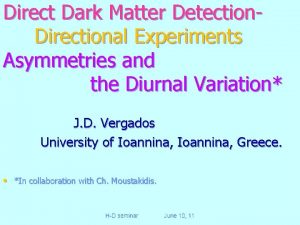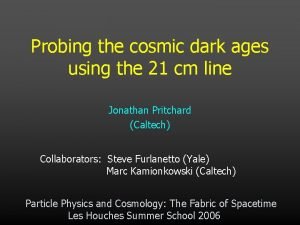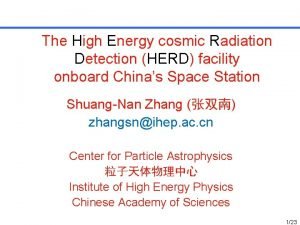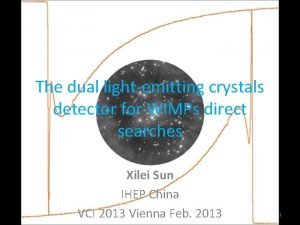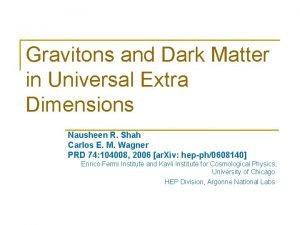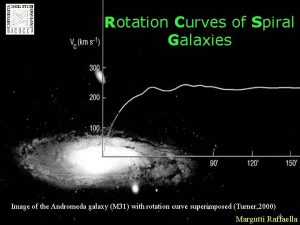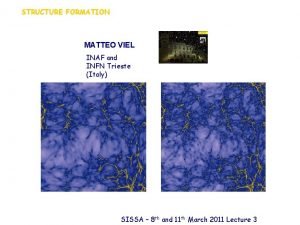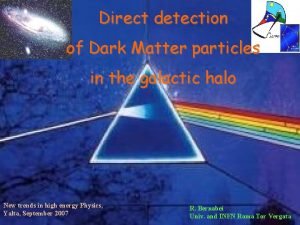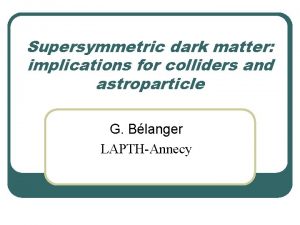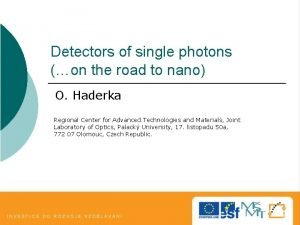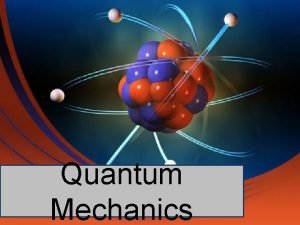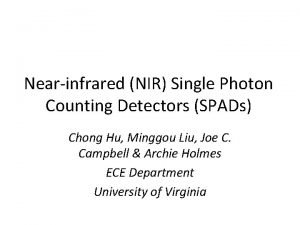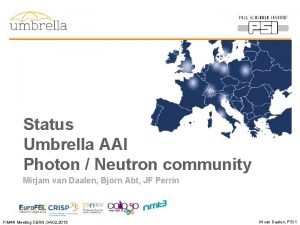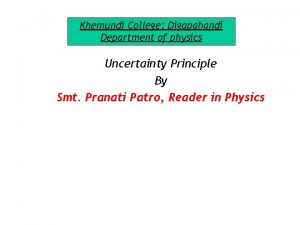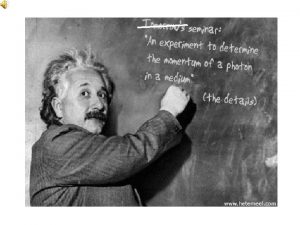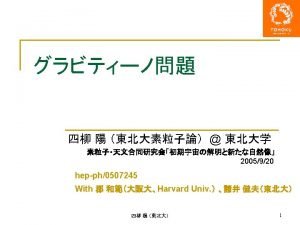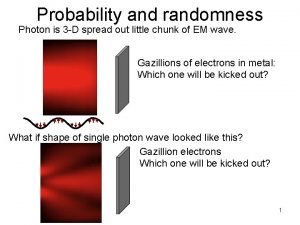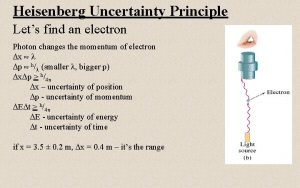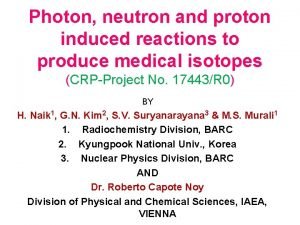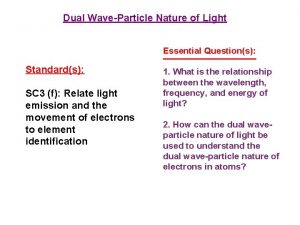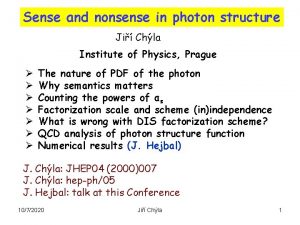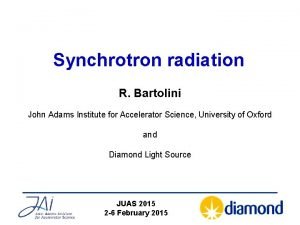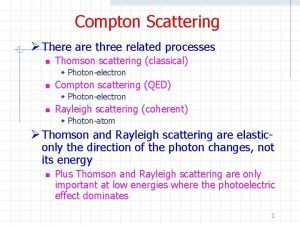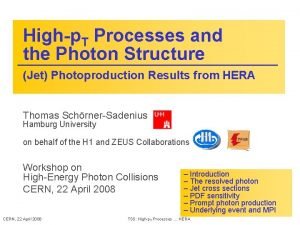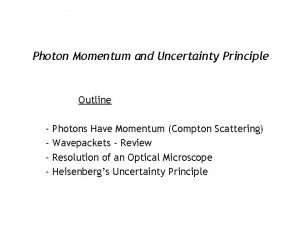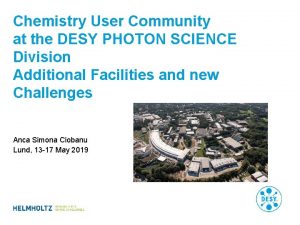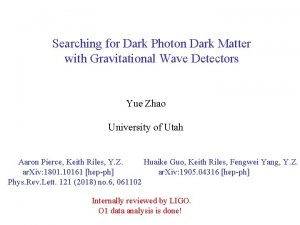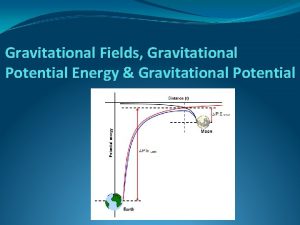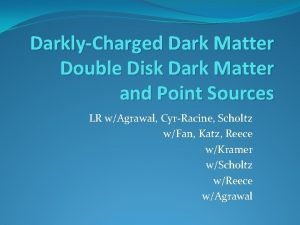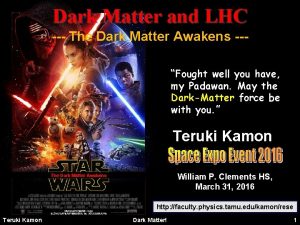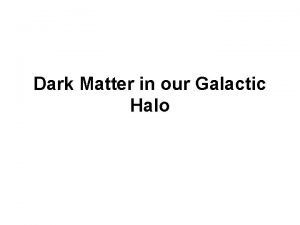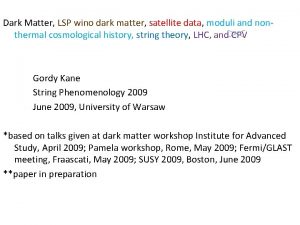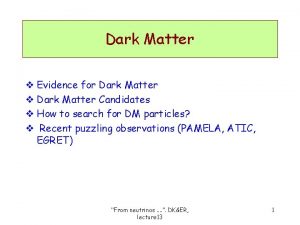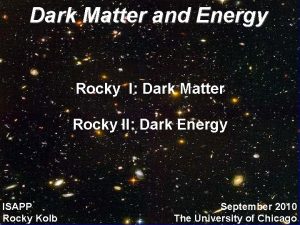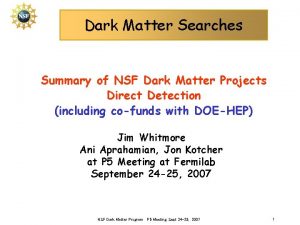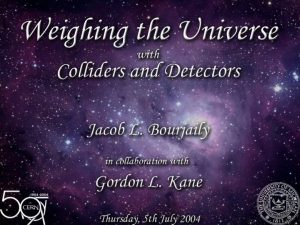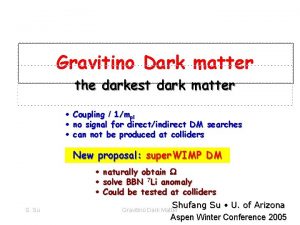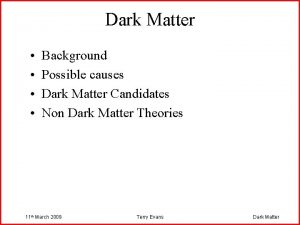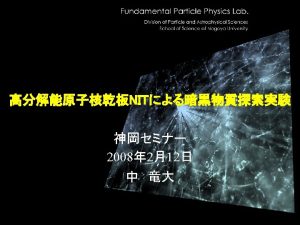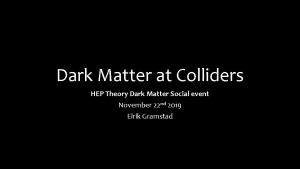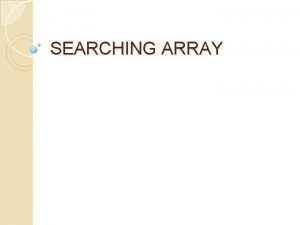Searching for Dark Photon Dark Matter with Gravitational



































- Slides: 35

Searching for Dark Photon Dark Matter with Gravitational Wave Detectors Yue Zhao University of Utah Aaron Pierce, Keith Riles, Y. Z. Huaike Guo, Keith Riles, Fengwei Yang, Y. Z. ar. Xiv: 1801. 10161 [hep-ph] ar. Xiv: 190 x. xxxxx [hep-ph] Phys. Rev. Lett. 121 (2018) no. 6, 061102 Internally reviewed by LIGO. O 1 data analysis is almost done!

Popular Choices: • WIMPs: • Very light DM particles Axion and Dark “Photon” -2 10 -22 e. V ~ 10 e. V Aaron Pierce, Keith Riles, Yue Zhao Phys. Rev. Lett. 121 (2018) no. 6, 061102 100 Ge. V ~ Te. V • Primordial Black Holes: -7 10 ~ 100 solar mass Huai-Ke Guo, Jing Shu, Yue Zhao Phys. Rev. D 99 (2019) no. 2, 023001 Both ultra-light and ultra-heavy scenarios can be proved by GW detectors!

Popular Choices: gauge boson of the U(1) B or U(1) B-L • Very light DM particles Axion and Dark “Photon” -2 10 -22 e. V ~ 10 e. V (p+n) (n) DM is an oscillating background field. Dark Photon is dominantly oscillating background dark electric field. Driving displacements for particles charged under dark gauge group.

Ultra-light DM – Dark Photon • Mass W/Z bosons get masses through the Higgs mechanism. A dark photon can also get a mass by a dark Higgs, or through the Stueckelberg mechanism. a special limit of the Higgs mechanism unique for U(1) gauge group • Relic abundance (non-thermal production ) Misalignment mechanism Light scalar (moduli field) decay Production from cosmic string Ultra-light dark photon can be a good candidate of cold dark matter!

Laser Interferometer Gravitational-Wave Observatory LIGO (ground-based) Amazing precision at LIGO: O(1/1000) the radius of a single proton! Opened a field: Gravitational Wave Astronomy Enrich our understanding on fundamental physics and early cosmology.

Laser Interferometer Space Antenna LISA (space-based) Recently approved by the European Space Agency. U. S. (NASA) just rejoined the program. LISA Path. Finder is a great success! (LISA Mission Consortium)

General Picture: LIGO/LISA: advanced Michelson–Morley interferometer (space. com) Gravitational wave changes the distance between mirrors. Change photon propagation time between mirrors. interferometer pattern

General Picture: Ultra-light DM: coherent state background classical radio wave (not the precise pic) Dark photon dark matter moves mirrors. Change photon propagation time between mirrors. interferometer pattern

Maximal Displacement: Local DM energy density: local field strength of DP >>

Maximal Displacement: dark photon coupling dark electric field charge mass ratio of the test object Silicon mirror: U(1)B : 1/Ge. V U(1)B-L : 1/(2 Ge. V) projected along the arm direction

Maximal GW-like Displacement: Compare this with the sensitivity on strain h. v vir =0 gives same force to all test objects, not observable. Net effect is proportional to velocity.

Properties of DPDM Signals: Signal: • almost monochromatic • very long coherence time DM velocity dispersion. Determined by gravitational potential of our galaxy. A bump hunting search in frequency space. Can be further refined as a detailed template search, assuming Boltzmann distribution for DM velocity. Once measured, we know great details of the local DM properties!

Properties of DPDM Signals: Signal: • very long coherent distance Propagation and polarization directions remain constant approximately.

Properties of DPDM Signals: Correlation between two sites is important to reduce background! dark photon field value Due to long coherence length, signal is almost the same for both sites.

Sensitivity to DPDM signal of GW detectors: First we estimate the sensitivity in terms of GW strain. (Allen & Romano, Phys. Rev. D 59: 102001, 1999) One-sided power spectrum function: energy density carried by a GW planewave Concretely predicted by Maxwell–Boltzmann distribution! A template search is possible, and a better reach is expected! We make simple estimation based on delta function as a guideline.

Sensitivity to DPDM signal of GW detectors: Signal-to-Noise-Ratio can be calculated as: observation time of an experiment, O(yr) overlap function describe the correlation among sites one-sided strain noise power spectra optimal filter function maximize SNR

Sensitivity to DPDM signal of GW detectors: DPDM: LIGO dark photon field value Livingston/Hanford: Approximately a constant (-0. 9) for all frequencies we are interested. Virgo (-0. 25) may be useful for cross checks.

Sensitivity to DPDM signal of GW detectors: DPDM: LISA dark photon field value Approximately a constant ( -0. 3) for all frequencies we are interested.

Sensitivity to DPDM signal of GW detectors: Translate strain sensitivity to parameters of DPDM: effectively the max differential displacement of two arms a GW with strain h change of relative displacement as h sensitivity of DPDM parameters (mass, coupling)

(People's Daily) Sensitivity Plot: Dark Photon Mass (e. V) (Eöt-Wash web) Loránd Eötvös LIDMO? Frequency (Hz) Eöt-Wash design sensitivities, 2 yrs

O 1 Preliminary Result:

Modeling DPDM background:

LIGO simulation output: TSFT = 1800 s

Earth Rotation Effects: broadening due to finite Tsft

Fine structure of the signal: Analytic understanding matches very well with numerical result!

Conclusion The applications of GW experiments can be extended! Particularly sensitive to relative displacements. Coherently oscillating DPDM generates such displacements. It can be used as a DM direct detection experiment. The analysis is straightforward! Very similar to stochastic GW searches. Better coherence between separated interferometers than Stochastic GW BG. The sensitivity can be extraordinary! O 1 data has already beaten existing experimental constraints. Can achieve 5 -sigma discovery at unexplored parameter regimes. Once measured, great amount of DM information can be extracted!

Sensitivity Plot: design sensitivities U(1) B-L charge mass ratio: 1/2 Ge. V operating for 2 years

LISA-like GW exp for PBH Extreme Mass Ratio Inspirals ABH SMBH gravitational wave signal LISA

LISA-like GW exp for PBH Extreme Mass Ratio Inspirals PBH SMBH gravitational wave signal Same frequency, but smaller amplitude! LISA

Master Formula: intrinsic EMRI rate well studied for SMBH-ABH rescale for PBH mass and density SMBH mass spectrum 10 4 - 107 provided in astrophysics volume integral truncated by SNR SMBH spin distribution likely to be almost extremal little effects to final results

GW Strain: M = 10 6 ; Spin = 0. 999 ; 1 Gpc

Sensitivity: One observation may be good enough to claim discovery!

Conclusion LISA-like GW detectors is powerful to search for PBHs! Large unexplored parameter space can be probed. -7 PBH mass: 10 ~ 10 Fraction can be as small as 10 -4. One or few signal events are good enough to declare discovery, if PBH is out of the mass regime of astrophysical COs. Non-COs (planets) are destroyed by tidal force before ISCO.

Conclusion Astrophysical uncertainties can be largely reduced by measurements on ABH-SMBH EMRIs. Mass spectrum and spin distribution of SMBHs. Help to remove hard cut-off at z=1. Lighter SMBH may be more useful to look for smaller PBHs. Larger Frequency Integration Regime (SNR) Guideline in future LISA-like GW experiments LIGO opens the era of GW astronomy. (Similar to the time when CMB is observed. ) Plenty astrophysics can be studied, as well as non-SM physics.

Dark Matter Overview: • Bullet Cluster (Deep Chandra) Why do we need DM? • Galaxy rotation curve (Wikipedia) • The CMB Anisotropy Power Spectrum (WMAP year 5 data)
 Dark matter and dark energy presentation
Dark matter and dark energy presentation In a dark dark town
In a dark dark town What could dark matter be
What could dark matter be Les houches dark matter
Les houches dark matter Dark matter pwo
Dark matter pwo Cindms
Cindms Matter gravitons other dimensions
Matter gravitons other dimensions Dark matter physics
Dark matter physics Matteo viel
Matteo viel Boosted dark matter
Boosted dark matter Where to stream dark matter
Where to stream dark matter Dark matter
Dark matter Dark matter
Dark matter Single photon detector
Single photon detector A photon checks into a hotel
A photon checks into a hotel Single photon
Single photon Photon neutron
Photon neutron Electron vs photon
Electron vs photon Momentum of photon
Momentum of photon Momentum of photon
Momentum of photon Lepton-photon
Lepton-photon Photon is our business
Photon is our business Photon chunk
Photon chunk Photon uncertainty principle
Photon uncertainty principle Ortec 257p
Ortec 257p Photon assay
Photon assay Energy of light wave
Energy of light wave Photon structure
Photon structure Photon density formula
Photon density formula Photoelectric and compton effect
Photoelectric and compton effect Photon structure
Photon structure Do photons have momentum
Do photons have momentum Institut für kernphysik
Institut für kernphysik Photon neutron
Photon neutron Desy photon science
Desy photon science Momentum units
Momentum units


